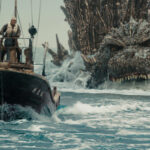Fremont, CA, USA – Wednesday, May 15, 2024 – Blackmagic Design announced today that Director Takashi Yamazaki’s latest work, the Oscar® winning “Godzilla Minus One,” was graded using DaVinci Resolve Studio editing, color grading, visual effects (VFX) and audio post production software. The grading was conducted by Colorist Masahiro Ishiyama of ARTONE FILM, using DaVinci Resolve Advanced Panel.
Directed, scripted and supervised by Takashi Yamazaki, “Godzilla Minus One” was produced to commemorate the 70th anniversary of the first Godzilla film. After its release in 2023, “Godzilla Minus One” received acclaim not only in Japan but also overseas, surpassing 17.5 billion yen in global box office revenue (as of the end of March 2024) and winning in the 96th Academy Awards® ceremony for Best Visual Effects.
“I first had the opportunity to handle the grading for Director Yamazaki’s previous work, ‘Ghost Book,’ and during the production of that film, I was also approached with the new Godzilla film,” said Masahiro Ishiyama, representative director and colorist at ARTONE FILM.
Regarding the creation of the look for the film, Ishiyama stated: “Given the post World War II era setting, the director expressed a desire to evoke the period’s atmosphere. However, we didn’t want to create a typical desaturated tone for depicting an old era. Instead, we aimed to maintain vivid colors while being mindful of the era. Therefore, I created a LUT for filming using DaVinci Resolve.”
Although the film was shot digitally, Ishiyama reproduced the “density” of film to convey the atmosphere of the period. “In digital, everything appears overly clear. Film, on the other hand, has its strengths and weaknesses. Therefore, I graded the film by breaking the delicacy of digital into gradients, creating smudges in the highlights and softening them. I also adjusted the luminance of red significantly to bring out the texture of the skin. By reducing the luminance of red, contrast is emphasized on people’s faces. Considering the period setting, there was no need to make the actors’ skin tones beautiful; instead, we aimed to create an atmospheric look.”
Additionally, Ishiyama used two different LUTs during grading. “One LUT, similar to a Kodak film look, was used for scenes in Ginza and others, with red tones in the shadows. This was created during test grading. The other LUT was used for the final battle scene, ‘Operation Wadatsumi,’ which took place at sea, to express the tension of the combat with a hard, cold look with a bleached bypass. In scenes where it was important to show the expressions of the characters, I used the masks on their eyes and tracked them, adjusting details using DaVinci Resolve’s Midtone Detail and Texture Pop functions. The eyes are quite important, so I adjusted them for all critical scenes. In movies and dramas, storytelling is paramount. I adjusted the colors while considering how to express the director’s direction, ensuring that the colors did not interfere with the story.”
The film underwent post production using an ACES workflow. “Shirogumi, the production company that handled the VFX, had extensive knowledge of ACES, and I also had experience with grading in ACES using DaVinci Resolve,” said Ishiyama. “Therefore, we decided to proceed with the ACES workflow this time. I created a LUT to ensure that all departments saw the same colors. Thanks to the ACES workflow, when we suddenly needed to create a Dolby Cinema version, I could adjust the highlights and shadows without clipping.”
Ishiyama continued: “When handing over the material to the Shirogumi team, I did match grading to adjust the color variations in the material. The variations in weather, especially in sea scenes, were significant. I thought it would be difficult to visualize the final image if they created CG from original material and the composite, so I provided them with the match graded shots as VFX plates. Then, they created CG based on those shots.”
In addition to the color version, a monochrome version of the film called “Godzilla Minus One/Minus Color” was also produced, with Ishiyama handling the grading. Regarding the creation of the monochrome version, Director Yamazaki requested the image of light and shadow similar to Leica’s monochrome photographs, with only the important parts being overwhelmingly visible.
“For example, in the sea scenes, I separated the RGB (red, green, blue) and desaturated them, reducing the luminance of everything except for red to create contrast. As a result, the sea becomes pitch black, with only people’s faces popping out. Yamazaki san commented that the sea looked scary. Since I aimed to create a film that would instinctively evoke fear and excitement in the audience, I believe we achieved a visceral experience,” Ishiyama concluded.
Press Photography
Product photos of DaVinci Resolve Studio, DaVinci Resolve Advanced Panel and all other Blackmagic Design products are available at www.blackmagicdesign.com/media/images
About Blackmagic Design
Blackmagic Design creates the world’s highest quality video editing products, digital film cameras, color correctors, video converters, video monitoring, routers, live production switchers, disk recorders, waveform monitors and real time film scanners for the feature film, post production and television broadcast industries. Blackmagic Design’s DeckLink capture cards launched a revolution in quality and affordability in post production, while the company’s Emmy™ award winning DaVinci color correction products have dominated the television and film industry since 1984. Blackmagic Design continues ground breaking innovations including 6G-SDI and 12G-SDI products and stereoscopic 3D and Ultra HD workflows. Founded by world leading post production editors and engineers, Blackmagic Design has offices in the USA, UK, Japan, Singapore and Australia. For more information, please go to www.blackmagicdesign.com


1 Comment
6ekilx